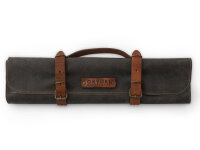"Knife set Yamato Hocho, 3 Japanese chef knives"
Japanese chef knives Yamato series
The Yamato series by Shizu offers a wonderful and easy introduction to all cooks who want to get to know the world of \"Japanese knives\". This is due to two criteria in particular: all knives in the series have a blade made of a high quality stainless steel (outer skin: SUS1A-1) and a high-carbon, hard cutting core made of AUS-8 using the Damascus technique. Japanese knives of this type thus offer a high level of comfort. The second point: Hand-forged Japanese knives are usually very expensive. With this series, Shizu has managed to offer very high quality despite the low price. With the hammered finish, the Yamato series adorns itself in a look typical of hand-forged Japanese knives. We have included a Santoku knife - the most popular knife shape in Germany - a sushi knife and a fish knife Deba, which is also very suitable for light chopping work, from this series in our offer.
How to use
Japanese chef's knives are made of extremely hard steels and are forged and ground thinner than their European counterparts. Some of these knives have very finely ground cutting layers, making them more delicate and suitable only for soft cut foods. Please refer to the product details for information in this regard. In particular, knives with a very thin cutting edge and hollow grind are prone to chipping on the blade. These are excellent for fine cuts of soft cut material, but should be used with appropriate care. Sharpening on a whetstone usually produces an angled grind, which makes the edge more stable over time.
Breakouts on the cutting edge can also occur due to leverage forces as well as frozen cuttings, which significantly reduce the temperature of the steel. Leverage forces often occur when cutting material with bones, for example. Chipping on the cutting edge may need to be ground out by a professional.
The knife should always be guided straight with pulling or pushing cut, without much pressure. To maintain sharpness, avoid cutting on stone, glass or other hard surfaces. Never use \"sharpening steel\" for resharpening. Water sharpening stones are recommended (grit: 400-1200 for preliminary sharpening, 3000 for fine sharpening, 6000 or more to strip the blade) and a honing leather if necessary.
Please keep the knife away from children. These knives are extremely sharp, please be careful.
All products are unique, so slight deviations from the exemplary picture are possible.
Care instructions
When using knives made of delicate types of steel, such as Aogami, Shirogami or V-Toku, please clean them occasionally with a cloth and water even during prolonged use. However, acidic foods can still cause discoloration on these classic carbon steels. After use, please wash by hand with hot water and use a neutral detergent if necessary. Please do not put the knife in the dishwasher under any circumstances. After cleaning, dry thoroughly, oil if necessary, and store in a well-ventilated area. Residual moisture can cause rust in non-stainless steels. See our posts on the ORYOKI Japan blog for product care.
Clean the knife by hand and do not use a dishwasher. Dry it thoroughly afterwards.























